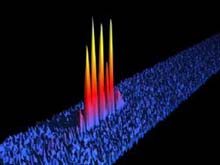

At sufficiently cold temperatures, the atoms in a gas can form what is known as a Bose-Einstein condensate (BEC), losing their individual identities and merging into a single quantum state. The phenomenon has fascinated physicists ever since gaseous BECs were created in the laboratory in 1995 (although the possiblity was first postulated some 70 years earlier), and a flurry of recent research has uncovered all kinds of remarkable condensate properties. Now researchers writing in the journal Nature have yet another discovery to add to that list. According to the report, BEC atoms trapped in a thin beam of light and forced to march single file can form atom waves that maintain a constant shape while propagating.
In their experiments, Randall G. Hulet of Rice University and his colleagues observed localized wave packets, or solitons, of lithium atoms traveling great distances–over a period of up to several seconds–without spreading. Caravans of up to 15 solitons were detected. The key appears to have been causing the atoms to attract one another, thus offsetting their natural tendency to disperse. Although this represents the first observed instance of so-called bright matter-wave soliton trains, localized wave bundles themselves are well known in high-speed optical communications networks, in which solitons of light enable the transfer of data across great distances without the help of signal boosters.
If you’re wondering what, exactly, such atomic soliton trains might be useful for down the road, the short answer is that it’s difficult to say. The authors speculate, however, that precision measurement applications such as atom interferometry might benefit from an atomic soliton laser, based on solitons like the ones they observed. “Forty years ago no one imagined that lasers would be used to play music in our cars or scan our food at the grocery store checkout,” Hulet muses. “We’re getting our first glimpse of a wondrous and sometimes surprising set of dynamic quantum phenomena, and there’s no way to know exactly what may come of it.”












